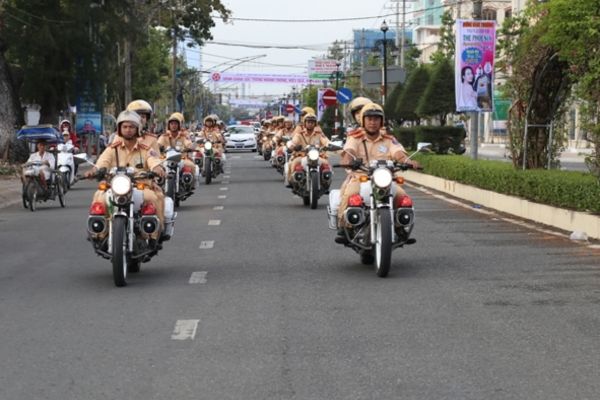Which traffic signal should road users obey when there are multiple traffic signals with different meanings in the same area?
Which traffic signal must a road user follow when there are multiple traffic signals with different meanings in the same area?
Based on Article 4 of QCVN 41:2019/BGTVT, the priority order of traffic signals is specified as follows:
When there are multiple traffic signals with different meanings in the same area, road users must comply with the type of traffic signal in the following order:
- Signals from traffic controllers;- Traffic light signals;- Traffic signs;- Road markings and other markings on the road surface.
When there is a fixed traffic sign at a location and another temporary traffic sign with different meaning is placed, road users must comply with the temporary traffic sign. Temporary signs are used in short-term situations for traffic control such as events, traffic incidents, or during road construction or repairs.
Examples:
- A motorcycle stops at a red light, but a Traffic Police officer signals to go, then the motorcycle can proceed.- A car on the road encounters a sign prohibiting bicycles. However, if a sign forbidding all vehicles is present, the car cannot enter.
Additionally, Article 44 of QCVN 41:2019/BGTVT specifies the place names on traffic signs as follows:
Each direction on the road can display up to three place names for guidance. The farthest place name is written at the bottom, and the order of places listed is maintained on the subsequent direction signs until the nearest place name is reached.
The place names and distances on the signs are as follows:
- Guided place names must be locations that the road passes through. The selection of place names for guidance follows the priority order below and is used on all road system types (CT, QL, DT, DH, DX, DDT) except for dedicated road systems:- Name of centrally-run cities;- Name of province-run cities;- Name of provincial administrative centers: do not report the province name unless it matches the name of the provincial center;- Name of district-level towns;- Name of district administrative centers: do not report district names unless it matches the name of the district administrative center;- Name of commune-level towns;- Historical sites or scenic spots;- Names of important intersections and endpoints of the road.

Which traffic signal must a road user follow when there are multiple traffic signals with different meanings in the same area? (Image from the Internet)
How are the signals from traffic controllers displayed?
Based on Clause 7.1 Article 7 of QCVN 41:2019/BGTVT, it is regulated as follows:
Traffic controller signals
7.1. The signals from the traffic controller are displayed using hand gestures, flags, batons, or traffic control light signals. To attract the attention of road users, the traffic controller may also use whistles in addition to the methods mentioned above.
According to these regulations, the signals from the traffic controller are displayed through:
- Hand gestures;- Flags;- Traffic control light signals;- Batons;- The traffic controller may also use a whistle to attract the attention of road users.
How are traffic control and inspection commands for stopping vehicles executed by the Traffic Police?
Based on Article 17 of Circular 32/2023/TT-BCA, the procedures for stopping vehicles for traffic control are specified as follows:
- Commands to stop vehicles for control at a point on the road, at the Traffic Police Station:
+ Traffic Police officers select a suitable position, stand upright, and face the vehicle that needs to be controlled. They signal to stop the vehicle at a safe distance using a traffic control baton, pointing at the vehicle to be controlled while decisively blowing the whistle, guiding the driver to stop at a suitable, safe position for control.
+ The driver, upon receiving the signal, must reduce speed and stop the vehicle at the position indicated by the Traffic Police.
- Commands to stop vehicles while being on a mobile patrol vehicle:
+ If the patrol vehicle is moving in the same direction and ahead of the vehicle to be controlled, the Traffic Police officer uses a traffic control baton, extends it horizontally to the right or left side of the patrol vehicle (depending on the lane the vehicle to be controlled is in), then raises it vertically, perpendicular to the ground; uses the whistle, loudspeaker, and emergency light signals of the patrol vehicle to guide the driver of the vehicle to be controlled to stop at a suitable, safe position for control.
The driver, upon receiving the signal, must reduce speed and stop the vehicle at the position indicated by the Traffic Police officer;
+ If the patrol vehicle is moving in the same direction and behind the vehicle to be controlled, the Traffic Police officer uses the loudspeaker and emergency light signals of the patrol vehicle to guide the driver of the vehicle to be controlled to stop at a suitable, safe position for control.
If necessary and safe, the patrol vehicle may overtake the vehicle to be controlled and issue the stop command as specified in point a of this clause. The driver, upon receiving the signal, must reduce speed and stop the vehicle at the position indicated by the Traffic Police officer.
LawNet